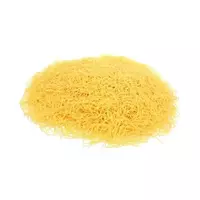Vermicelli

According to most nutritionists, regular consumption of this product does not contribute to the appearance of excess weight at all, although the calorie content of vermicelli is quite high and amounts to 337 kcal per hundred grams of pasta. It practically does not contain fat, in connection with which it is possible to recover only from a variety of sauces and gravy, which are served to these wheat flour products.
It's no secret that vermicelli is called a type of pasta that differs in its shape (thin short sticks) and is prepared based on fresh dough. By the way, it is thanks to this form that the vermicelli has its own name, which is translated from Italian as worms.
It is not difficult to cook vermicelli at all: you need to pour it into boiling, pre-salted water and stir regularly to avoid burning. To prevent the vermicelli from sticking together during the cooking process, it is necessary that it swims freely in a saucepan. Basically, the cooking time of this product is always listed on the packaging.
Ready-made vermicelli is most often served with vegetable dressings, olive oil, and tomato or cream sauces. In addition, vermicelli is used as an excellent side dish for meat, fish and poultry dishes, and it is also often added to soups.
Vermicelli species
To date, it is customary to distinguish between three main types of vermicelli - ordinary, amateur and cobweb. A distinctive feature of each variety is the thickness, which is different for each vermicelli. So, the thinnest type of vermicelli is the web, which is most often added when preparing all kinds of soups and other first courses.
Composition of vermicelli
It is worth noting that regardless of the varieties of this pasta, the composition of the vermicelli remains unchanged: wheat flour, drinking water and table salt. The soft wheat flour product has too much gluten in its composition, which is practically of no value to the body. Therefore, it is much more useful to use vermicelli prepared from hard wheat, since it contains crystalline starch, which is not destroyed during the preparation of vermicelli, and also retains valuable proteins.
In addition, vermicelli made of solid wheat varieties contains a sufficient amount of proteins, vitamins B, E, PP and H, amino acids, as well as such vital and sometimes essential elements as iron, magnesium, calcium, potassium and some others. All these substances make vermicelli very useful for eating a food, but only if you choose exclusively pasta from hard wheat flour and eat the finished dish in its pure form without satisfying and incredibly high-calorie sauces.
Vermicelli 337 kCal
Energy value of vermicelli (Ratio of proteins, fats, carbohydrates - ju):
Proteins: 10.4 g (~ 42 kCal)
Fats: 1.13 g (~ 10 kCal)
Carbohydrates: 74.9 g (~ 300 kCal)
Energy ratio (b | y): 12% | 3% | 89%
 Español
Español Français
Français Português
Português Русский
Русский 简体中文
简体中文 繁體中文
繁體中文 日本語
日本語 한국어
한국어 العربية
العربية Türkçe
Türkçe Қазақ
Қазақ Deutsch
Deutsch Italiano
Italiano Українська
Українська
